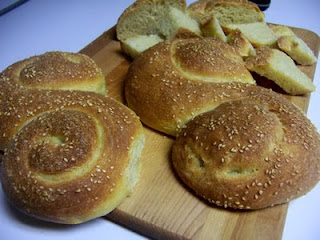This week, we're continuing our series on pumpkin breads. The bread of the week is a beautiful Pumpkin Cranberry Braid. The wonderful blend of spices gives the bread a delicious burst of flavor! I saw this bread on Sugarcrafter a couple of weeks ago and I just had to try it.

Some friends invited us to dinner last night so I thought this was a good opportunity to make some special bread and share it with our new friends. I brought one of the pumpkin cranberry loaves to dinner and everyone loved it -- especially my taste tester. I put the other loaf in the freezer to save for another special occasion or maybe for some Bread Pudding.
Editor's note: I like what Sandy (At the Baker's Bench), the very gracious hostess of the BYOB, had to say about this bread, "Those of you dining at others' homes this Thanksgiving take note: this bread looks like the perfect hostess gift (but be advised that it may steal the show ~ so practice your humble face in advance)." Very wise words indeed!
I submitted this beautiful bread to BYOB for the November 1st roundup. Be sure to check out all of the wonderful breads in the Nov 1st BYOB Roundup.
Pumpkin Cranberry Braid
Makes: Two 10-inch braided loaves
From: The kitchen of Sugarcrafter
Ingredients:
- 4 1/2 cups bread flour
- 1 tsp cinnamon
- 1 tsp ground ginger
- 1/8 tsp ground cloves
- 1/8 tsp ground nutmeg
- 1/3 cup sugar
- 1 1/2 tsp salt
- 1 Tbsp instant yeast
- 1/3 cup dried cranberries
- 2 eggs
- 1/2 stick butter, melted
- 1 3/4 cups pumpkin (I used about 2 cups of roasted pumpkin puree.)
Directions:
In a large bowl, mix together the flour, cinnamon, ginger, cloves, sugar, salt, and yeast. In a separate bowl, mix together the eggs, butter, and pumpkin. Add the wet ingredients to the dry ingredients, stirring until well-combined. Knead the dough with a stand mixer for 2 minutes (3 minutes by hand).
Let the dough rest for 15 minutes, then continue kneading for about 5 more minutes until smooth (8-10 minutes by hand).
Turn the dough out on to a lightly floured surface. Divide it in half. Then divide each half into three pieces.
Roll each piece out to about 10-inch log.
For each loaf, braid the pieces together as shown below, then pinch the ends together and tuck them underneath.
Cover them with plastic wrap and allow to rise for another hour. The loaves should look puffy, though not necessarily doubled in bulk. Mine doubled in bulk.
Bake the bread in a preheated 375°F oven for 20 to 25 minutes, until lightly browned and a cake tester inserted in the center comes out clean. Remove the braids from oven, and allow them to cool on a wire rack.
I brushed them with melted butter first, then let them cool on the wire rack.
Serve the loaves warm or at room temperature. I wrapped the loaves in plastic wrap because they were too big to fit in a bread bag.
If any bread is left over after a few days, use it to make bread pudding. Try this Bread Pudding Recipe.
You might enjoy some of these other Pumpkin Bread Recipes. Or, this Ginger Pumpkin Braid Recipe.
Happy Baking!
Cathy


































































